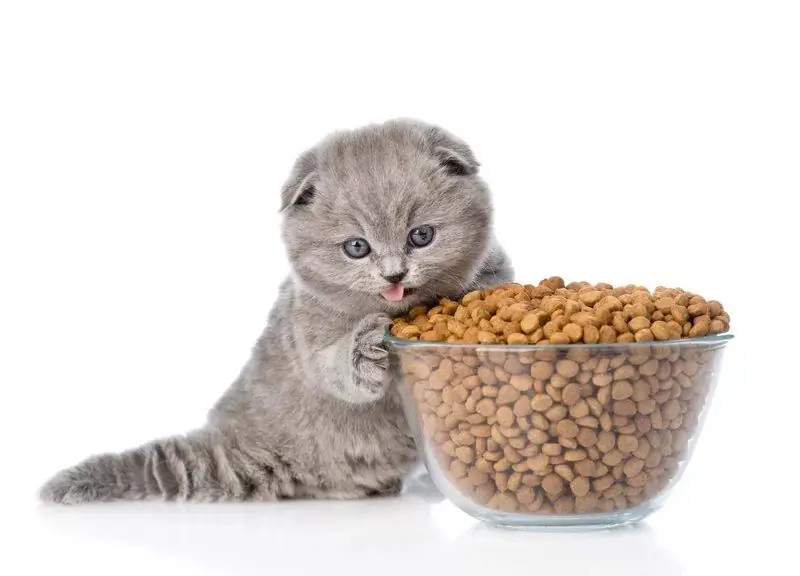
Table of contents:
- Author Bailey Albertson [email protected].
- Public 2023-12-17 12:53.
- Last modified 2025-01-23 12:41.
What is the difference between kitten food and adult cat food?
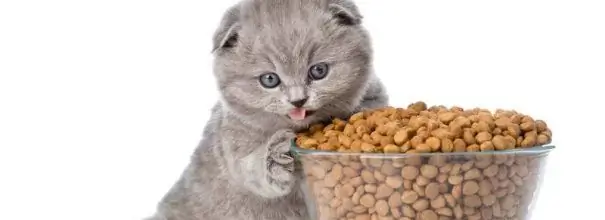
Many dry food manufacturers additionally produce special ready-made rations for kittens. The formulation for toddlers is distinguished by the concentration of nutrients and energy value, as well as the size of the granules. The difference in composition is due to anatomical and age characteristics. In some cases, adult cat food can cause internal disruption in kittens.
Content
-
1 What is the difference between dry food for kittens and ready-made diets for adult cats
- 1.1 Granule size and structure
- 1.2 Energy value
- 1.3 Protein and fat content
- 1.4 Concentration of vitamins and minerals
- 2 Is it possible to give the kitten food for adult cats
- 3 How and when to transfer a kitten to adult cat food
- 4 The opinion of veterinarians
- 5 Reviews of kittens owners
What is the difference between dry food for kittens and ready-made diets for adult cats
Most often, a fundamental difference in composition is found only in the case of not very high-quality feed: economy and premium class. As the kitten needs more nutrients, producers are forced to either alter the proportions of nutrients with supplements or use more meat and organ meats instead of plant extracts. The latter method is more common in bona fide corporations: kittens absorb substances better when they are presented with whole ingredients. In the case of holistic, sometimes the difference can only be in the size of the granules, since manufacturers do not save on raw materials.
Granule size and structure
Most often, manufacturers produce more porous granules for babies, so that it is easier for them to gnaw the pieces with their baby teeth. At the same time, it helps to cleanse the canines from plaque and prevents the formation of calculus. Pellets in kitten food are usually smaller because the large chunks are difficult for babies to handle.
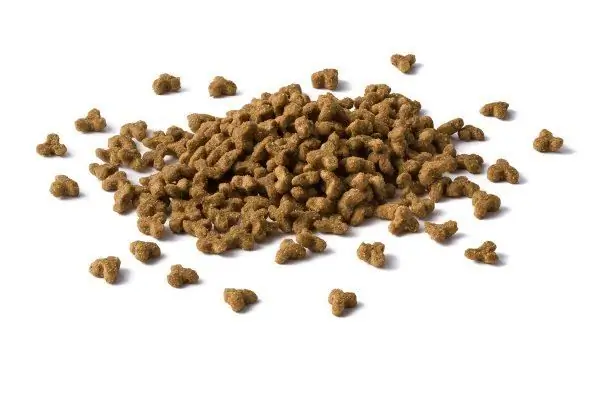
Kitten food pellets can have an unusual shape: a heterogeneous structure is more attractive to animals, which improves appetite and makes it easier to train to ready-made diets
Cat teeth are not intended for thorough grinding of food: due to the anatomical features, the mouth of a predator is more adapted to tearing meat from a large carcass. In addition, it should be borne in mind that kittens' enamel is about 10 times thinner than human enamel. For these reasons, granules that are too large can cause dental problems and further decay.
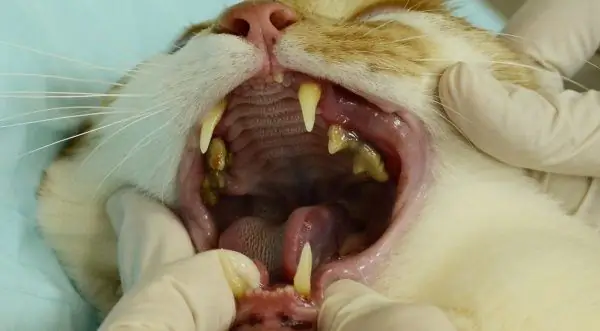
Tartar appears as yellowish or dark plaque deposits near the roots of the canines.
The reverse exchange is also dangerous: adult cats can choke on small granules. I have a grown up kitten (6 months) and an adult cat at home. I have to give them one food, because the old-timer is used to free access and steals from someone else's bowl. I chose the holistic Grandorf for kittens, but the granules in it are too small for my cat. He does not chew them, swallows them whole. After a month of such food, the pet had an unpleasant smell from the mouth, upon examination, I found a plaque. Since the composition of the food suits me perfectly, I began to brush the cat's teeth with a brush.
Energy value
In most cases, the energy value of kitten feed is about 20-30 kcal per 100 g. This is due to the increased physical activity of babies and the phase of rapid growth of internal organs. If an adult cat sleeps primarily to conserve energy, kittens fall asleep solely because of fatigue. Theoretically, a pet can get more calories if it eats more granules, but this is not encouraged: the load on the gastrointestinal tract increases, which, if there is a predisposition and risk factors, can cause the development of pathologies.
From personal experience, I can say that the difference in terms of calorie content for a kitten does not play a big role, but for an adult animal it is dangerous. When I gave the pets different foods, the old-timer always went to the beginner's bowl first. Apparently, the diets for kittens are more attractive due to the higher content of proteins and fats. For a month, an adult cat has put on weight by 200 g. By feline standards, this is a lot, especially considering that he already has a dense physique. But when kittens are fed with "adult" rations, exhaustion does not occur: the sister gave her kitten 1st Choice and Orijen, he was playful and active, the ribs were felt with little difficulty.
Protein and fat content
Little kittens need more amino acids, since they are involved in the process of division and creation of new cells, and are also needed for the correct functioning of the central nervous system, cardiovascular system and other organs. In baby food, manufacturers are trying to add more meat - the most affordable source of protein. With joint feeding for healthy adult cats, an increase in the concentration of proteins is not dangerous, but if there are even small deviations, this will provoke pathological changes in tissues.
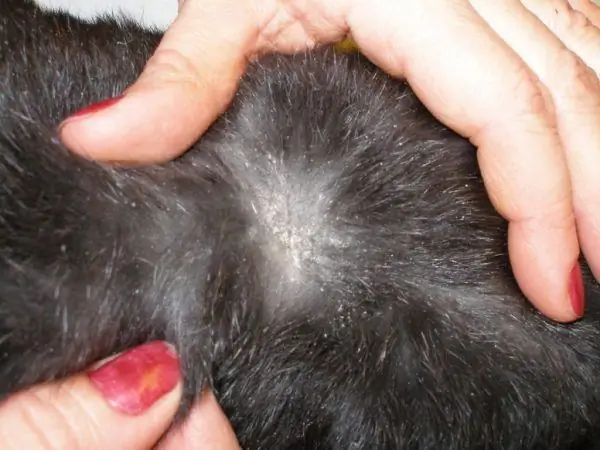
Deficiency of amino acids and lipids can provoke increased shedding and flaking of the skin
Kittens need fats not only as a source of energy, but also as a building material for internal organs and tissues. Lipids allow maintaining the work of many internal systems: the digestive tract, central nervous system, brain, heart, etc. The proportion of fat in kitten feed reaches 20%, for adult cats the standard is 10-15%. A low lipid concentration most often does not cause any deviations in babies, but with a strong deficiency in animals, weakness and lethargy are observed. There is a small chance of disruption of the cardiovascular system. Against the background of a lack of lipids, a deficiency of fat-soluble vitamins may occur due to a deterioration in metabolism.

Low nutritional value of feed can lead to overeating and further development of obesity
On the market of budgetary feeds, there is a tendency to create an outwardly attractive balance of proteins, fats and carbohydrates due to not the most nutrients: hydrolysates of vegetable proteins, peas, cereals, etc. Conventionally, these ingredients do contain a certain amount of amino acids and lipids, but the data compounds are not assimilated by the short digestive tract of predators. The only available protein source for a cat is from animal products. For this reason, it is important to be guided not only by the balance indicated on the package, but also by the composition, otherwise the animal will regularly lack nutrients. The presence of meat ingredients in the first places and the presence of fish oil, a source of unsaturated fatty acids, are encouraged. It is advisable to avoid cereals and diets with anonymous animal fats in the composition.
Concentration of vitamins and minerals
Since kittens develop their musculoskeletal system and teeth change rapidly in childhood, they need more calcium and phosphorus. The increased concentration of zinc stabilizes tissue growth, prevents the appearance of defective cells, strengthens the immune system and normalizes hormones, which is especially important for adolescents. Iron controls the development of internal organs and provides oxygen transportation. Magnesium contributes to the normal functioning of the cardiovascular system, the load on which is higher at a young age.
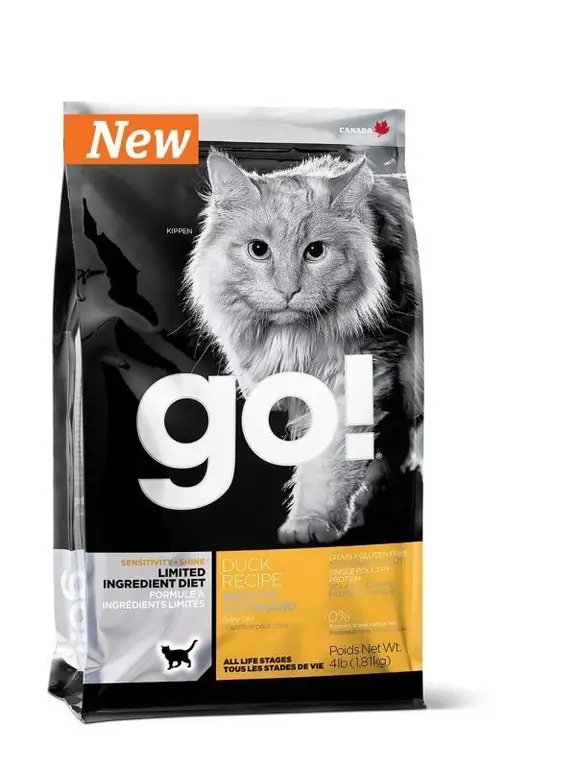
The absence of a separate specialized recipe in the lines of elite brands should not confuse buyers: in the wild, kittens and adult animals eat the same products
Theoretically, the difference in nutrient proportions is small, so healthy kittens will not experience deviations from eating inappropriate food. Problems will appear if the animal has even minor violations. For example, metabolism is impaired, due to which the kitten assimilates fewer nutrients. The presence of abnormalities in the work of internal organs is not always obvious, therefore it is better not to take risks and give the baby suitable food. It is advisable to prefer ready-made diets in which vitamins and minerals are not present in pure form, but as whole ingredients.
When fed together, kitten food can be hazardous to adult animals. Neutered pets are especially likely to have health problems. Oversaturation of food leads to the formation of calculi in the urinary system.
Can a kitten be given food for adult cats?
The answer to the question of whether kittens can be fed with adult cat food primarily depends on the quality of the finished diet. Holistic will be more beneficial than a budget specialized product, since the former contains more substances available to the kitten. It is better to give up whiskas, Friskas, Kitiket and the like in favor of Akana, Origen, Pronatur Holistic, etc. It is also advisable to avoid premium class products (Royal Canin, Hills "," Proplan "), because they contain low quality raw materials and too many cereals. Even specialized feeds in the line are significantly inferior to conventional super premium products.
In general, a kitten can feel good when eating "adult" ready-made diets, but to prevent nutritional deficiencies, it is recommended to use such products only as a temporary alternative. If the baby steals some food from the bowl of older cats, there will be no dangerous consequences as long as specialized food remains the basis of the menu.
The situation is different when it comes to incomplete feed, that is, delicacies. Most often they are made from by-products: stomachs, lungs, veins, kidneys and other internal organs. A kitten's delicate gastrointestinal tract may not cope with the load, which at best will lead to indigestion, at worst - to severe diarrhea and dehydration, inflammation of the mucous membranes of the stomach or intestines, or blockage. Treats for adult cats can be given to the animal only after a year.
How and when to transfer a kitten to adult cat food
There is no general conditional boundary for translation. Most experts believe that an adult cat is considered after one year. Some felinologists argue that it is possible to transfer a pet to a new diet only after the final formation of internal organs. The period of active growth differs depending on the sex of the animal and individual characteristics. On average, a cat's body is fully formed by 11-12 months, cats take longer - 13-14 months.
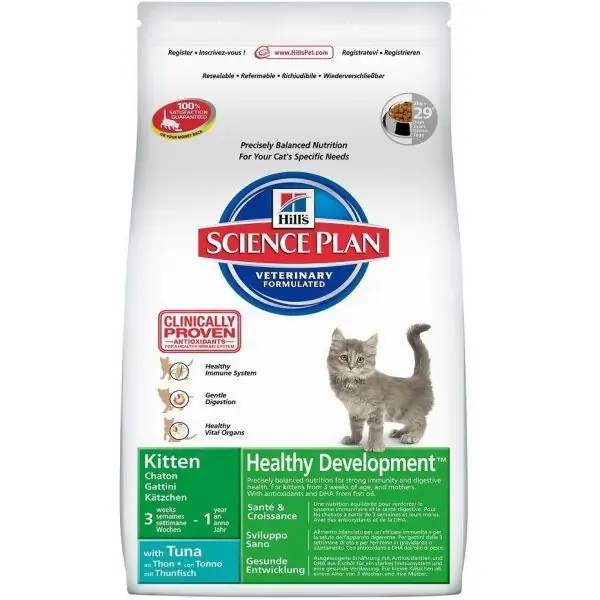
Many manufacturers specify the age range and note that after a year, the animal is recommended to be transferred to another feed.
It is advisable to translate slowly and not to change the feed brand. Within one line, the chemical composition of the products is stable, for their production the company uses the same raw materials. With an abrupt transition to a new feed, digestive upset may occur. This is especially dangerous for animals with hypersensitivity or gastrointestinal pathologies. In urgent cases, a quick switch to food for adult cats is allowed if it is carried out within the same line, but it is better to prefer a gradual habituation.
Granules of "adult" food are offered to a kitten from 8-10 months as a delicacy in order to test the body's reaction and begin to gradually adapt the internal organs to the new composition. At 12-14 months, the animal is mixed with the ready-made diet in the usual food, gradually increasing the proportion of the former. Ideally, the translation should take 10-14 days. The amount of new feed can be increased by about 10% every day, or you can change the diet in jerks: replace about 1/5 part and observe the reaction for several days, then repeat until the old product is completely excluded from the menu. The choice of method is carried out individually.
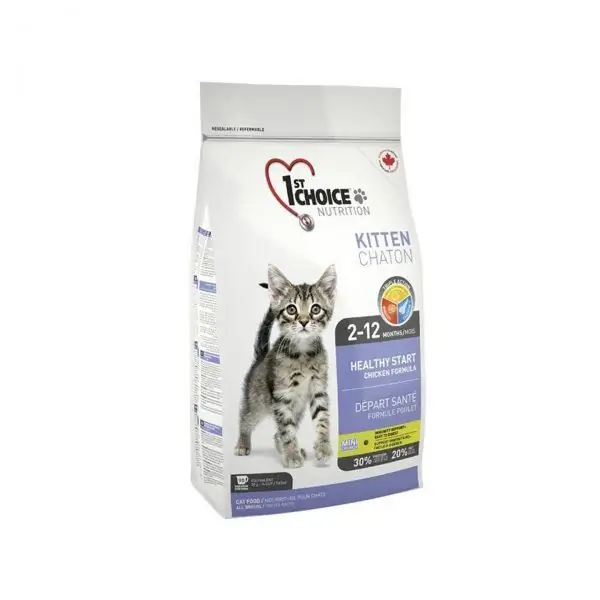
Kitten food is suitable only for healthy animals, in the presence of pathologies, you need to consult a veterinarian
Since kitten food is often more attractive, the animal may refuse food or choose only tasty pellets. In such cases, it is advisable to persist and continue translating unless there are any specific symptoms that might indicate an illness. Sooner or later, the animal will give up and start eating as usual. It is not recommended to offer your pet treats, persuade and hand-feed. This will lead to the appearance of finickyness and impaired appetite.
Fast or too early transfer is possible after castration or in the event of illness, if the feed has been prescribed by a veterinarian. After surgery, the diet is changed to avoid obesity and the development of ICD. In case of liver and kidney diseases, "baby" food can cause exacerbation.
The opinion of veterinarians
Kitten owners reviews
The most preferred food for kittens is holistic. If the pellets are small enough, even "adult" prepared rations can be fed to the animal. In the case of premium and super premium segment lines, it is advisable to choose a specialized product. Most often, such diets are more expensive due to the high content of meat and some nutrients, but they provide the harmonious development of internal organs during the period of active growth.
Recommended:
Is Dry Food Harmful For Cats: Dangerous Ingredients In The Composition, What Harm Can Low-quality Food Cause, The Opinion Of Veterinarians
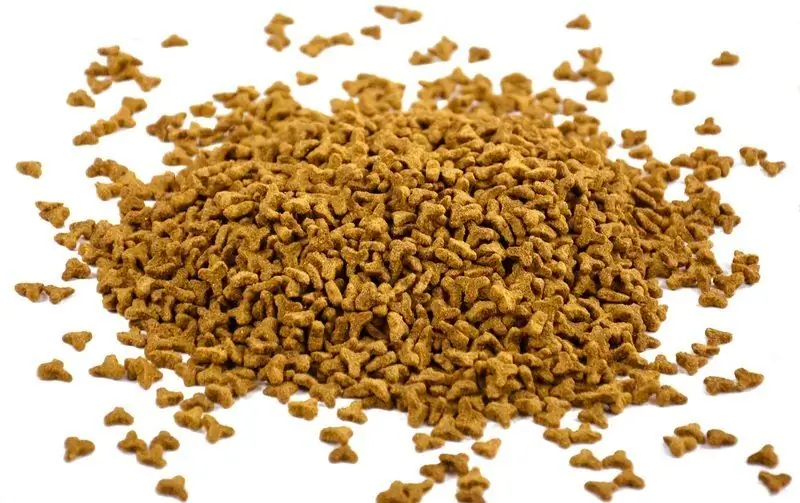
Are ready-made diets dangerous for cats? What diseases can dry food cause? How to choose a safe and healthy product
How To Feed A Kitten At 1 Month Without A Cat: How To Feed Newborn Cats At Home, Recommendations Of Veterinarians
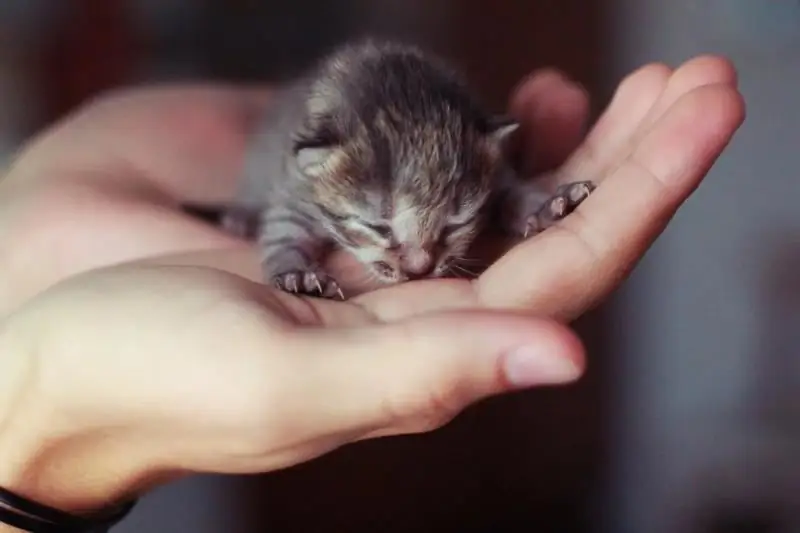
How to feed and care for a kitten without a cat. What is needed for feeding. Mix selection. Transfer to self-catering. Kitten weight gain
Is It Possible To Soak Dry Food For Cats And Cats: Features Of Soaking For Adult Animals And Kittens, Recommendations Of Veterinarians
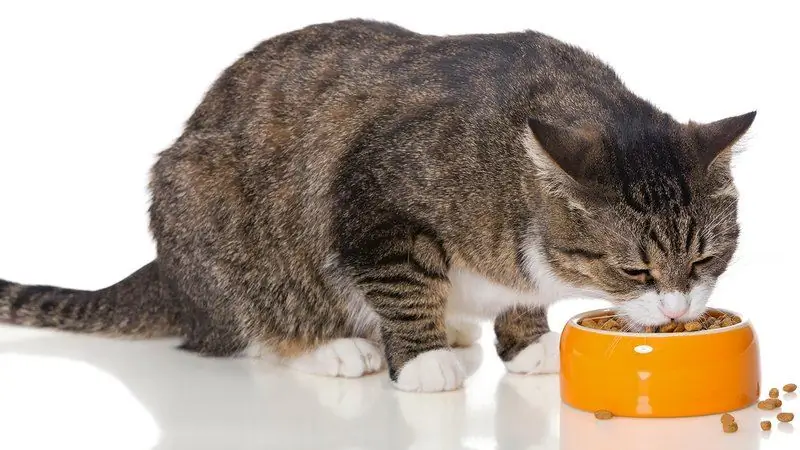
Is it possible and when it is necessary to soak dry food for cats and kittens, how to do it correctly, is it possible to store soaked food. Veterinarian recommendations
What Food To Feed The Maine Coon (adult Cat And Kitten): Dry And Wet Food, Recommendations, Permitted And Prohibited Foods
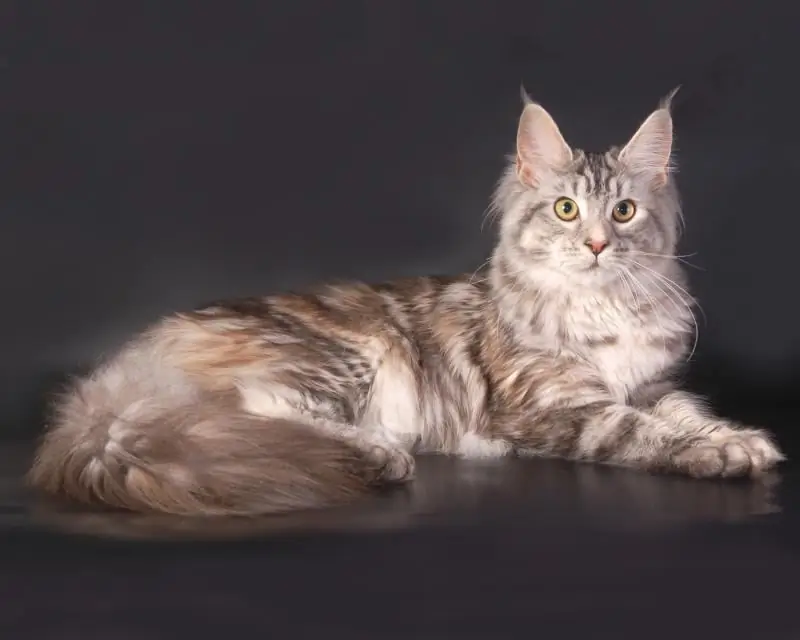
How to feed a kitten and an adult Maine Coon cat. What products are allowed to be given to animals. How to choose dry food for Maine Coon
Is It Possible To Give A Cat Dog Food: Why It Is Impossible To Feed It, How The Composition, Harm And Benefit Differ, The Opinion Of Veterinarians

Can I feed my cat dog food? How dangerous is an unsuitable diet for a pet. How to stop stealing food from someone else's bowl
